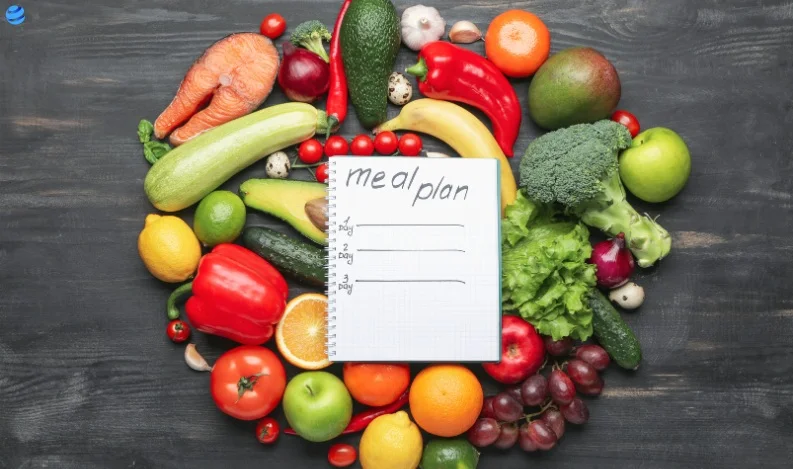Healthy eating is important for everyone. It helps our bodies grow strong and keeps us feeling good. But sometimes, planning healthy meals can seem hard, especially if you are just starting. This blog will make it easy for you to understand how to plan meals that are both healthy and simple.
Why Healthy Eating is Important
Strong Body and Mind
Healthy eating gives your body the fuel it needs to grow and be strong. Just like a car needs petrol, our bodies need good food to work well. When we eat healthy foods, we get the energy to play, learn, and stay active. Healthy eating also helps our brains work better, so we can think clearly and do well in school.
Prevents Illness
Eating the right foods can help prevent illnesses. Healthy foods like fruits, vegetables, and whole grains have vitamins and minerals that protect our bodies from getting sick. When we eat well, we are less likely to catch a cold or feel tired.
What is Meal Planning?
Planning Ahead
Meal planning means thinking ahead about what you will eat for your meals. Instead of deciding what to eat at the last minute, you plan your meals for the week. This helps you make sure you are eating healthy foods every day.
Saving Time and Money
When you plan your meals, you save time because you know what to cook. You also save money because you only buy the ingredients you need. This way, you do not waste food.
How to Start Meal Planning
Step 1: Know Your Food Groups
To plan healthy meals, you need to know the different types of foods. These are called food groups. There are five main food groups:
-
Fruits: Apples, bananas, oranges, and berries.
-
Vegetables: Carrots, broccoli, spinach, and peas.
-
Grains: Bread, rice, pasta, and oats.
-
Protein: Chicken, fish, beans, and eggs.
-
Dairy: Milk, cheese, and yoghurt.
Each meal should have foods from different groups to make it balanced.
Step 2: Choose Simple Recipes
Start with easy recipes. Look for meals that do not have too many ingredients. Simple recipes are quicker to make and usually healthier. For example, you can make a salad with lettuce, tomatoes, and chicken. Add some bread on the side, and you have a balanced meal.
Step 3: Make a Shopping List
Before you go shopping, write down what you need. Look at your recipes and list the ingredients. Only buy what is on your list. This helps you stay focused and avoid buying unhealthy snacks.
Tips for Healthy Meal Planning
Plan for Variety
Eating the same food every day can get boring. Make sure to plan different meals for each day. Try to include a variety of foods from each group. For example, if you have chicken one day, try fish the next day. This keeps your meals interesting and ensures you get all the nutrients you need.
Cook in Batches
Cooking in batches means making a lot of food at once. You can cook a big pot of soup or stew and eat it over several days. This saves time and makes sure you always have a healthy meal ready. You can also freeze some meals to eat later.
Snack Smart
Healthy eating is not just about meals; snacks are important too. Plan for healthy snacks like fruits, nuts, or yoghurt. Avoid sugary snacks like biscuits and cakes. Healthy snacks keep your energy up between meals.
Drink Plenty of Water
Water is the best drink for your body. It keeps you hydrated and helps your body work well. Plan to drink water with every meal and throughout the day. Avoid sugary drinks like fizzy drinks or juices with added sugar.
Sample Meal Plan for Beginners
Breakfast
-
Day 1: Porridge with berries and a glass of milk.
-
Day 2: Scrambled eggs on whole-grain toast with a banana.
-
Day 3: Yoghurt with honey and a handful of nuts.
Lunch
-
Day 1: Chicken sandwich with lettuce and tomato, an apple on the side.
-
Day 2: Vegetable soup with whole-grain bread, and a small orange.
-
Day 3: Tuna salad with mixed greens and a slice of cheese.
Dinner
-
Day 1: Grilled fish with steamed broccoli and brown rice.
-
Day 2: Pasta with tomato sauce and a side of mixed vegetables.
-
Day 3: Stir-fried chicken with peppers and carrots, served with quinoa.
Snacks
-
Day 1: Carrot sticks with hummus.
-
Day 2: A small handful of almonds.
-
Day 3: A piece of fruit, like an apple or pear.
Overcoming Challenges
Lack of Time
Some people think they do not have time to plan meals. But meal planning can actually save you time. Spend a few minutes each week planning your meals and making a shopping list. This will make your week run more smoothly, and you will have more time to enjoy healthy meals.
Eating Out
Eating out can make it hard to stick to healthy eating. But you can still make good choices. Look for menu items that are grilled or baked instead of fried. Ask for vegetables instead of chips. You can also plan to eat out less often and cook more at home.
Staying Motivated
It can be hard to stick to healthy eating if you are used to different foods. But remember why you started. Eating healthy makes you feel good, keeps you strong, and helps you do well in school and activities. If you have a bad day, do not worry. Just try again the next day.
Making Healthy Eating a Habit
Start Small
You do not have to change everything all at once. Start with small changes. Add more fruits and vegetables to your meals. Swap white bread for whole-grain bread. Drink water instead of sugary drinks. Small changes can make a big difference over time.
Involve the Whole Family
Healthy eating is easier when everyone in the family is involved. Talk to your family about your meal plan. Ask them to help you choose healthy recipes and shop for groceries. Cooking together can be a fun way to spend time and learn about healthy eating.
Keep Learning
There is always more to learn about healthy eating. Read books, watch videos, or ask a teacher about nutrition. The more you know, the easier it will be to make good choices.
Conclusion
Meal planning is a simple way to make sure you are eating healthy every day. By knowing your food groups, choosing simple recipes, and planning ahead, you can create meals that are both delicious and good for you. Remember to start small, involve your family, and keep learning. Healthy eating is a habit that will benefit you for life.
Let’s make healthy choices and keep our bodies strong and happy!
You may also like:-
This blog will guide beginners through the essentials of meal planning, offering practical advice on creating balanced, nutritious meals without feeling overwhelmed. It will include tips for portion control, grocery shopping, and meal prepping, making healthy eating more accessible. With easy-to-follow recipes and a focus on simplifying the process, readers will learn how to build lasting habits for better nutrition and overall wellness.














